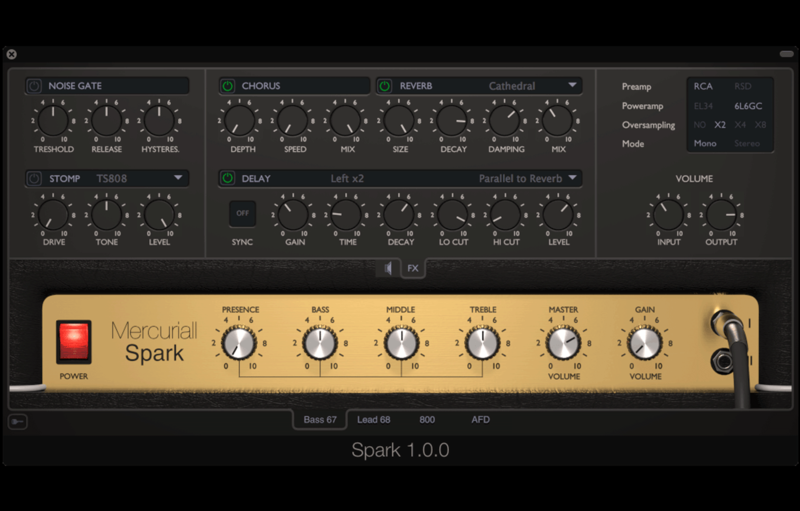Spark is a VST/AU/AAX plugin that models four Marshall® tube amplifiers, four guitar cabinets, four overdrive pedals and a set of the most common spatial effects.
Modeling
Spark is the realization of all our latest achievements in the field of real-time electric circuits modeling. First of all, it’s a tube push-pull power amplifier that is working with a reactive load (guitar cabinet), with negative feedback and electric feed chains. This allowed us to implement a truly realistic poweramp saturation (very important for the majority of the Marshall®-based amps), realistic work of the Presence knob and made possible to take into account the influence of the output and power transformers.
We have considerably improved the cabinet section. Apart from the smooth positioning of microphones, we added an option to mix sound of two mics. This allows you to find pretty much any desired sound. There are four cabs and three microphones at your disposal.
Despite the fact that Spark is an amp and cab sim above all, we gave a lot of attention to the FX section. There is a Noise Gate at the input, as well as a number of pedals: there are currently four overdrives, implemented with our proprietary technology of the electric chain modeling. As for the spatial effects – there are Chorus, Delay and Reverb.
Spark’s UI continues our approach of simple usability at no expense to a wide functionality. All main actions require just a single click. We pay a lot of attention to the design, that passes a lot of iterations of adjustments and improvements, offering you a very simple and functional solution.
Key Features
- Electronic circuits of amps and pedals are modeled with our custom technology using Neural Networks
- Pedals, preamp and power amp are working within the same oversampling cycle. Thus, there is no latency build-up and no additional losses when using several anti-aliasing filters
- Realistic and smooth positioning of up to two microphones simultaneously
- Several preamp and power amp tubes to choose from
- Stereo-mode: right and left channels are modeled independently. This mode is useful for processing stereo signals. For example, a panned double tracked guitar
- Delay and reverb can be used in parallel to get a more expressive effect without extra routing
- Plugin supports CPU multi-threading
- Standalone version
Amp section:
- Based on Marshall® AFD (four channels)
- Based on Marshall® JCM 800 (two channels)
- Based on Marshall® JMP Super Lead (two channels) with Master Mod
- Based on Marshall® JMP Super Bass (two channels) with Master Mod
- Tubes: 12AX7 RCA, 12AX7 RSD; 6L6GC, EL34
Cab section:
- Based on Bogner® Uberkab 412 – 4×12 Celestion® G12T-75
- Based on popular American metal cab – 4×12 Celestion V30s
- Based on Marshall® 1960B – 4×12 Greenback
- Based on Marshall® 1960B – 4×12 JBL® K120 (vintage)
- Microphones: Shure® SM57, Sennheiser® MD441, Royer® R121
- Cabinet IRs by Redwirez
Pedals and FX section:
- Noise Gate
- Overdrive based on Ibanez® TS-808
- Overdrive based on Ibanez® TS-808 Lower Drive Mod
- Overdrive based on Ibanez® TS-7 Hot
- Overdrive based on an American pedal
- Overdrive based on Boss® Super Overdrive
- Stereo Chorus
- Stereo Delay
- Stereo Reverb
Additional settings:
- Oversampling: no, x2, x4, x8
- Sample-rate: 44.1, 48, 88.2, 96
- Stereo processing allowed
PC
- Intel or AMD with SSE2 support, 2 cores and 4 threads, 2.8 GHz
- Windows 8 or newer
- VST 2.4 compatible or Pro Tools 11
- Internet Required (for software activation)
MAC
- Intel Core 2, 2 cores and 4 threads, 2.8 GHz or Apple Silicon M1
- macOS 10.13 or newer
- AU or VST 2.4 or AAX64 compatible
- Internet Required (for software activation)



















